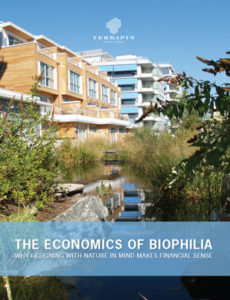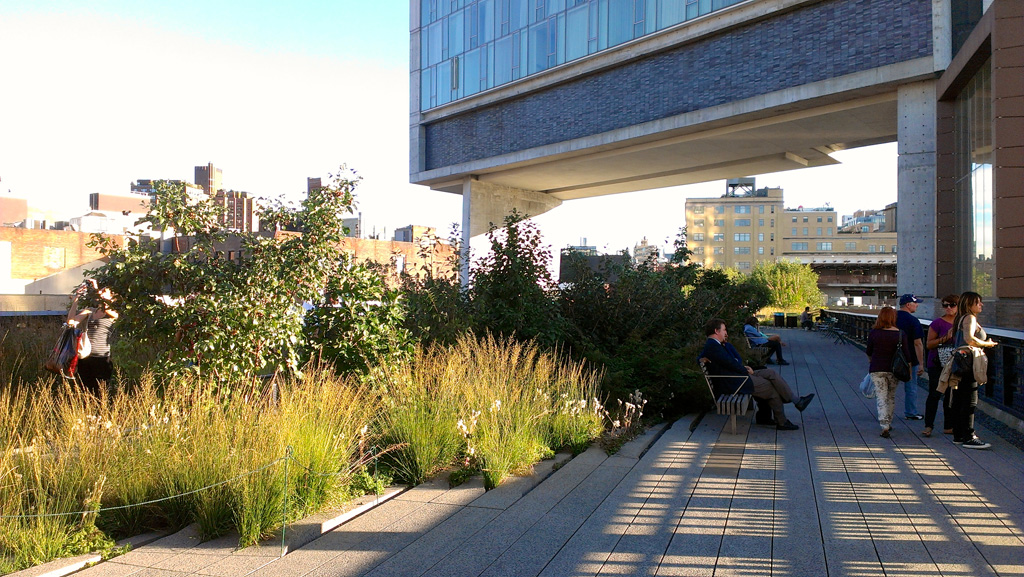Highline Park, New York. Credit: Kārlis Dambrāns /Flickr

Terrapin Bright Green is an environmental consulting and strategic planning firm committed to improving the human environment through high performance development, policy, and related research, in order to elevate conversations and help clients break new ground in thinking creatively about environmental opportunities. Since 2006, Terrapin Bright Green and a network of specialists have worked to shape the outcome of large-scale planning and design projects around the world. Terrapin has offices in New York City and Washington, DC, and works with private companies, public institutions, and government agencies on a variety of project types.
“The Economics of Biophilia” is a six-part republication of “The Economics of Biophilic Design” by Terrapin Bright Green. As a series, each section explores one of five economic indicators as it relates to biophilic design: workplace, healthcare, education, retail, and community.
The Economics of Biophilia: Introduction
Why designing with nature in mind makes financial sense
Humans have traditionally improved the places in which we live and work to increase our comfort and productivity. These improvements have often been based on technological advancements that enhanced the health and welfare of building occupants, but have paid little attention to our more subtle physiological needs. Recent advancement in our understanding of natural systems, coupled with a growing awareness of the subtle neurological and physiological functions associated with contact with nature, have increased our ability to identify appropriate strategies for increasing economic gains, improving productivity, and strengthening the social fabric of communities.
In the last twenty years, studies examining the human attraction to nature have yielded convincing evidence that link interactions with nature with positive gains in productivity, increased healing rates, and even enhanced learning comprehension. These investments in health and productivity may affect more sectors than initially anticipated. The monetary gains from providing people access to biophilic design range from increased retail sales and improved cognitive development in students, to savings associated with safer urban communities. Read more
In today’s society, sectors across industry are reaping the economic benefits of biophilic design. By examining five of these sectors—workplaces, healthcare, retail stores, schools, and communities—we can begin to understand the fiscal implications of biophilic design across the economy. The numbers and percentages presented reflect powerful evidence that design and planning strategies informed by nature can lead to positive impacts on human health, child development, community safety, and worker satisfaction. These effects translate directly to increased profits.
The Economics of Biophilia: Workplace
DRIVING PROFIT MARGINS IN THE WORKPLACE
Companies across a widening range of industries from technology to manufacturing, have had similar success using their biophilic workplace and green building to entice top prospective employees to join their organization. The Bank of America Tower at One Bryant Park in Manhattan was designed as an iconic building and to ensure that 90% of all employees had views to parks, green roofs and/or rivers, with the explicit purpose of attracting and retaining the best employees. This shift to incorporate nature into workplace design continues as companies see the financial benefits of biophilic workplaces. Read more
The Economics of Biophilia: Schools
BETTER FUTURES FOR SCHOOLCHILDREN – BIOPHILIC DESIGN IN EDUCATIONAL SETTINGS
It is time to start relying on our affinity to nature to design schools that use biophilic standards to complement the efforts being made to improve educational curricula. The lessons from the healthcare and other sectors show that their biophilic standards decrease costs while improving outcomes. Keeping children in school until they graduate and helping them to focus their attention on learning has immense benefits to society at large. Read more
The Economics of Biophilia: Healthcare
HEALTHIER PATIENTS, HEALTHIER PROFITS – BIOPHILIC DESIGN IN HOSPITALS
Spending in the United States’ healthcare sector is at record levels and growing. In 2016, the U.S. spent $3.3 trillion on healthcare (U.S. Department of Health and Human Services (HSS), 2016) and that number is expected to rise to $5.7 trillion by 2026 (U.S. HSS , 2016a). Reducing these costs without sacrificing health outcomes is critical for the economic stability of the hospital system and its users. Biophilic design strategies can contribute to improved outcomes as an evidence-based solution.The process of evidence-based design for healthcare settings combines the best information from other fields, in this case current healthcare design research and the physiological and psychological needs of patients, doctors, and staff (Hamilton & Watkins, 2009). Read more
The Economics of Biophilia: Retail
THE IMPORTANCE OF NATURE IN RETAIL SPACES
Akin to the hospitality sector, retail space design serves many practical functions from a marketing standpoint. Exterior design elements need to attract attention and interest new customers. Interior design should elicit effective shopping practices and further exploration. Both should contribute to a positive perception of brand, increasing the acceptable price for its products. Biophilic design has been shown to support each of these goals. By acknowledging important tenets of environmental psychology in conjunction with our innate desire to affiliate with nature, biophilic retail spaces can improve occupant experience, ultimately translating into increased revenue. Read more
The Economics of Biophilia: Communities
THE COST BENEFITS OF NATURE IN COMMUNITIES
Integration of green space into urban design cultivates a society that is more aware and invested in a long-term shift toward generations that are healthier, more productive, and more connected to nature. This shift could be manifested in an increase in the agency of marginalized or overlooked sections of the future labor force. Another way of addressing this could be a change in the structure of the real estate landscape. Recognizing the premiums that green properties generate could change building codes and best practices in construction in the long run, resulting in urban areas that move towards reconnecting with the native landscape. The fact that these kinds of changes are already used to highly positive effect in cities like Singapore, should encourage governments, urban designers, developers and architects to follow their lead. Read more

